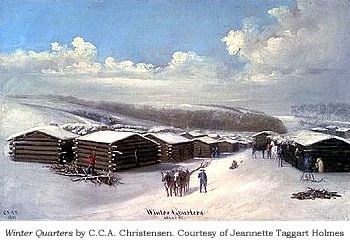
Church of Jesus Christ of Latter-day Saints Brigham Young initially intended for his Mormon vanguard out of Nauvoo to overwinter in the Rocky Mountains and then continue to the Great Basin in spring 1847. However, the difficulty of the journey, fatigue, and starvation changed his plans. The 1846 trek would be from Nauvoo, Illinois, to the Missouri River at today’s Omaha, Nebraska; and the 1847 journey would continue from there to the Great Salt Lake Valley at present-day Salt Lake City, Utah. The first 260 miles tested the vanguard Mormons most severely. Leadership was disorganized and groups strung out along the trail. Men forayed into settlements along the route to barter or labor for food and hay. Freezing nights, steady rain, axle-deep mud, and flooding streams slowed the company’s progress and caused tremendous suffering among the emigrants. The first death along the trail occurred on March 18 at Richardson’s Point, Iowa, where a man succumbed to illness and exposure. At the end of March, Young reorganized the camp into three companies of 100 families each. These were subdivided into “Fifties” and then tens, with captains for each unit. The new discipline helped, but weeks of slogging had exhausted the emigrants and depleted their provisions. On April 24, the wagons stopped on the prairie about halfway across Iowa, 144 miles west of Nauvoo. Here the Mormons established a farm settlement called Garden Grove, where the weakest travelers would stay and plant crops to feed the second wave of emigrants, already on their way. They established another farm settlement, Mount Pisgah, 30 miles up the trail near today’s town of Murray, Iowa. Meanwhile, Young sent wagons back to Nauvoo to carry out the remaining emigrants, those too poor or ill to start west on their own. On May 14, advance riders spotted 18 wagons up ahead: they were part of the spring exodus that had rolled out of Nauvoo once the grass was high enough to feed the oxen. Because they were well supplied and road conditions had improved, these companies took just three weeks to catch up with Young’s weather-beaten, starving vanguard pioneers—who at this point had been trudging across Iowa for two and a half months. On June 14, 1846, the wagons reached the Missouri River at Council Bluffs, Iowa. The trip from Sugar Creek had taken 105 days, covering approximately 260 miles at an average of two and a half miles per day. They could go no farther. Some of the company stayed on the Iowa side of the river, forming a settlement they named Kanesville and scattering to isolated family camps in places having wood for their cooking fires and grass for their cattle. Others crossed the Missouri and dug in at the main settlement, Winter Quarters, in present-day Omaha. Oncoming emigrants from Nauvoo joined them throughout the summer. More than 700 Mormon people died on the prairie from exposure, malnutrition, scurvy, tuberculosis, pneumonia, malaria, and other diseases during the winter and spring of 1846-47. More Mormon Trail History:
|
Last updated: April 23, 2025
